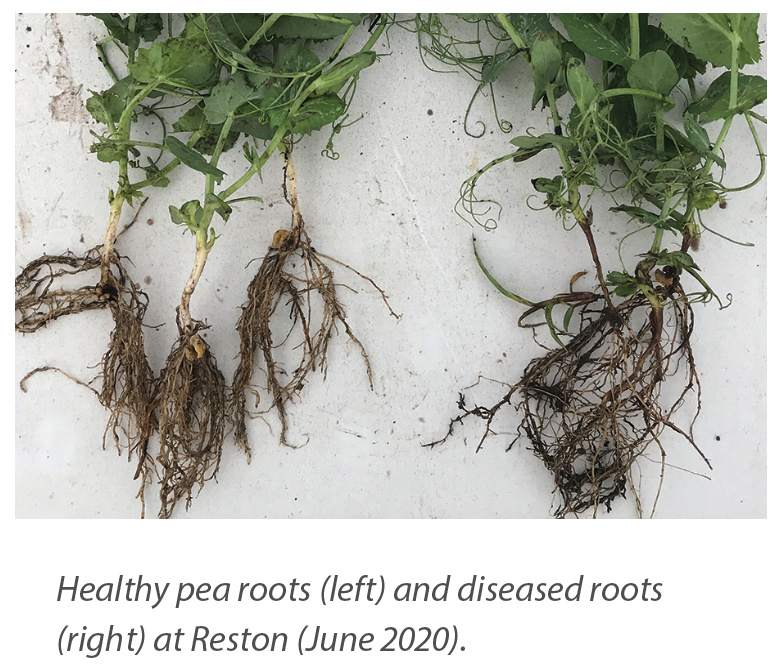Westman Agricultural Diversification Organization – Spring 2021 Pulse Beat
Intercropping is nothing new in agriculture. It’s been around for hundreds of years — for example, the Native Americans grew beans, squash and maize called The Three Sisters. Fast forward to 2020, ancient methods are resurrected under modern-day industrial mechanization and field crops.
Many benefits are often realized with intercropping: fewer weeds due to increased crop competition, fewer insect pests such as aphids in pea–canola intercrops or reduced risk from environmental woes like excessive moisture or frost. Despite benefits come challenges, such as weed control, harvestability, aligning maturities and economic costs to separate the different crop types from one another, just to name a few. Today’s computer statistical programs can shed insight into what the ancients could only prophesize at the time.
Roquette’s pea processing facility in Portage la Prairie is interested in learning more about those benefits and challenges of intercrops and what it means for both the farmer’s and their company’s bottom line. In 2020, Roquette field agronomist Jennifer Theroux approached Scott Chalmers, WADO manager, to do seeding rate field trials at Melita. With peas as the primary focus and knowing that canola, oats and barley have decent reputations as being good companions with peas, they wanted to investigate what influence different seeding rates would have on final yield, quality (protein and disease) and most importantly, economics.
Though it’s only the first year of results, they found that all three crops did well with peas. Whether it was peas with canola, barley or oats, the combinations increased field yield (total land equivalent ratio (TLER)) by 22–27%, respectively. Nitrogen fertilizer was not applied to the trials, as WADO knows from previous pea–canola research that it usually has no benefit to the overall yield or economics. When economics were applied to these substantial yield increases, benefits quickly evaporated due to additional seed cleaning costs associated with intercrops (Tables 1, 2 and 3). It was an excellent pea year at Melita, but the net revenues of the intercrops were no better nor no worse than monocrop peas, except for the barley intercrops that generally had lower net revenue.
Aside from neutral economic outcomes, other intercrop benefits were discovered, such as slightly lower leaf disease and earlier maturity in barley, ease of harvest, a significant increase in barley and oat protein, and fewer pea splits in pea-oat intercrops compared to monocrop peas.
WADO is no rookie when it comes to intercrops — they have been researching them since 2009. Currently, Scott and his team have been working on a couple of other projects in peas funded by Manitoba Pulse & Soybean Growers, the Canadian Agricultural Partnership and Western Grains Research Foundation.
The first project is looking at the agronomic and economic parameters of intercropping peas with either canola, mustard, flax, wheat or oats, called the Multi-Crop Intercrop Trial. This project is being run at WADO (Reston and Melita sites) and the Prairie Crop Diversification Foundation (PCDF) at Roblin.
Scott notes that the first two years (2019 and 2020) of the three-year study indicated canola, mustard and oats serve as the most promising companion crops with peas. WADO is finding consistent over-yielding year to year in the promising crops, and that wheat and flax have fallen behind due to the difficulty of harvesting these crops with peas. Wheat or flax both require high combine cylinder speeds and tight concave clearance in order to thresh properly. Peas require the opposite. WADO has found that to thresh wheat or flax properly, the peas must take a beating, causing them to split and break, losing yield and quality. Whereas oats, mustard and canola have similar settings as peas, allowing those intercrops to thresh properly.
Scott indicates that compared to Melita or Roblin, the Reston site has unique challenges, as the presence of both Fusarium and Aphanomyces root rots has had substantial effects on pea performance. To put it into perspective, in 2020, Reston yielded just 3 bu/ac while Melita yielded 74 bu/ac without the crippling effects of root rot. When peas are under this sort of stress, the companion crops “pick up the slack” and produce a satisfactory crop and income. Whereas peas grown alone at the Reston site lost money after production costs were taken into account.
The second trial also at the Reston location, called the Pea–Mustard–Canola Intercrop Trial, is looking at the influence of either canola or mustard seeding rates with peas to determine: 1) what rate works best and 2) if there are any secondary influences on pea production success, such as changes in disease incidence and severity.
Again, two of the three years are complete in this second study. One of the key features of this study is the assessment of root rots in peas caused mainly by a complex of Fusarium species and Aphanomyces. Root samples were dug up after emergence/prior to flowering and sent to AAFC Lethbridge for Dr. Syama Chatterton and her team to decipher the prevalence of these pathogens based on the copies of DNA they quantify. To date, the trials have seen inconclusive evidence that canola and mustard as companion crops influence the effects of these diseases in peas.
Keep up to date on the progress of these trials by visiting the Manitoba crop diversification centres website: mbdiversificationcentres.ca or the MPSG website: manitobapulse.ca/research.





